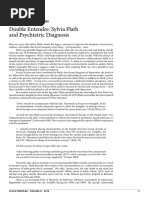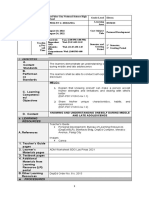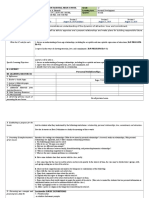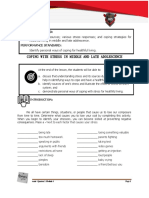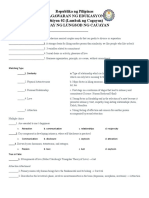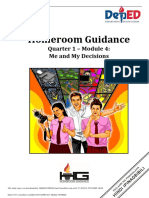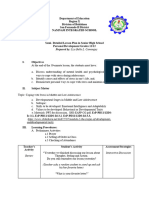Personal Development Quarter 2 Module 7
Uploaded by
DAPHNEE MAE AGUDONGPersonal Development Quarter 2 Module 7
Uploaded by
DAPHNEE MAE AGUDONGNORTHWESTERN
UNIVERSITY
LEARNING COMPETENCIES:
1. Discuss an understanding of teen-age relationships, including the acceptable and
unacceptable expressions of attractions
2. Express his/her ways of showing attraction, love, and commitment
3. Identify ways to become responsible in a relationship
MODULE 7 : PERSONAL RELATIONSHIPS
INTRODUCTION:
Relationships are the framework of
our lives. Therefore, how contented we are
whether we are friends or family, associated
romantically or connected by way careers,
relies on how fulfilled our relationships are.
The concept of relationship is very broad and
complex. In our model, personal relationships
refer to close connections between people,
formed by emotional bonds and interactions.
These bonds often grow from and are
strengthened by mutual experiences’.
1. Checkpoint 1
Direction: List down ways of making and meeting acquaintances/friends in the past and at
present.
PAST NOW
Personal Development - Quarter 2 Module 7 Page 1
NORTHWESTERN
UNIVERSITY
Personal Relationship
The word relationship submits to a broad range assortment of societal connections
where varying levels meet interpersonal desires. Interpersonal relationship are about the
relationships people share within their parents, spouse, siblings, friends and associates,
employer or employees, teachers and instructors, among others.
Relationships help in meeting personal needs and targets. It could be that one is feeling
lonesome and would like to have an outlet for the isolation felt.
Friendship
Friendship is a form of relationship between
two or more people.
It means being with others and not just
thinking about yourself
It is during adolescence that you make time
for friends and even hangout with them.
According to Parker and Asher (1993) there are three identified types of friendship
during adolescence stage.
1. Acquaintances, which are the type of friendships whom you join only once in a while or
occasionally such as fellow members of a choir or school organization.
Personal Development - Quarter 2 Module 7 Page 2
NORTHWESTERN
UNIVERSITY
2. Companions, which are the type of friends where you share same
interest through regular interactions such as team mates in a basketball team
3. Intimate or best friends, which are types of friendships where you give and receive
opinions and support.
You may opt to have one or two close friends, but some teenagers find it very easy to
mingle with others, resulting in them having a circle of friends.
Arthur (1999) describes two types of peer groups where most teenagers associate---
cliques and crowds. Cliques is usually composed of smaller members (4 to 6 members) and is
exclusive to peers who share same interests. Crowd is a larger peer group, composed of 10-20
members and the crowd share similar activities such as parties.
Importance of Relationship
Relationships maintain happiness and health
Relationships avoid isolation
Relationships meet interpersonal requirements
Relationships serve as behavioral anchors
Relationships serve as communication channels
Good relationships maintain self-worth
Lead us to make healthy relationships
Help us see our potential
Boost our confidence
Give you a sense of direction
Clear our life goals and aspirations
Build a beautiful person with in you
How are attachments developed?
Attachment theory is a concept in
developmental psychology that concerns the importance
of "attachment" in regards to personal development.
Specifically, it makes the claim that the ability for an
individual to form an emotional and physical
"attachment" to another person gives a sense of stability
and security necessary to take risks, branch out, and
grow and develop as a personality. Naturally, attachment theory is a broad idea with many
expressions, and the best understanding of it can be had by looking at several of those
expressions in turn.
Personal Development - Quarter 2 Module 7 Page 3
NORTHWESTERN
UNIVERSITY
Psychologist John Bowlby was the first to coin the term. His work in the
late 60s established the precedent that childhood development depended heavily upon a child's
ability to form a strong relationship with "at least one primary caregiver"
Attachment styles as defined by by Ainsworth,Blekar and Wall 1978
1. Secure attachment is classified by children who show some distress when their
caregiver leaves but are able to compose themselves and do something knowing that
their caregiver will return. Children with secure attachment feel protected by their
caregivers, and they know that they can depend on them to return.
2. Avoidant Attachment- Parents of children with an avoidant/anxious attachment tend
to be emotionally unavailable or unresponsive to them a good deal of the time. They
disregard or ignore their children's needs, and can be especially rejecting when their
child is hurt or sick.
3. Anxious-ambivalent attachment is when the infant feels separation anxiety when
separated from the caregiver and does not feel reassured when the caregiver returns to
the infant. Anxious-avoidant attachment is when the infant avoids their parents.
Disorganized attachment is when there is a lack of attachment behavior.
3 Brain Systems of Love: Lust, Attraction, and Attachment
While love is complicated and can’t simply be reduced to three biological brain states,
there are clear neurochemical processes that do contribute to feelings of love. While not called
‘love’, the desire to mate with a specific individual is not limited to humans, but exists across
many species. The drive to find a mate, bond, and reproduce is called the ‘attraction system’.
This system is made up of three fundamental pathways -- lust, attraction and attachment –
which occur in both birds and mammals (including humans).
1. Lust- Is sex really all that guys think about? Possibly. But women think about it too.
Lust is our sex drive or libido and it is in part driven by the hormones testosterone and
estrogen. Lust refers to an urge or desire that motivates us to partake in sexual activity.
This desire to be involved in sexual activity is there regardless of whether someone has
a sexual partner or not.
2. Attraction -Although often described as part of lust, attraction is distinguished from
lust because it involves focusing our attention to a particular person or desire. Lust on
the other hand is our libido; it is the underlying urge for sexual gratification. Attraction is
also in part driven by different hormones than is lust, with adrenaline, dopamine and
Personal Development - Quarter 2 Module 7 Page 4
NORTHWESTERN
UNIVERSITY
serotonin playing key roles. Ultimately, engaging in sexual activity may
be just as dependent upon individual attraction as it is upon lust.
3. Attachment- Attachment is a deep and enduring emotional bond that connects one
person to another across time and space (Ainsworth, 1973; Bowlby, 1969).
Ways on how Attraction to Someone is expressed
When you talk about your crush to your friends, you sometimes feel very much excited.
All these feelings of excitement about a crush are normally experienced at your age. However,
how you express your feelings of attraction or admiration is another area of concern. For some
having a crush is like having an aspiration. They become more motivated to study their lessons
and performance well at school. However, for some, having a crush becomes a distraction.
They cannot concentrate on their studies and spend more time talking and thinking about their
crush. This is one common problem that a teenager must be aware of.
Having a crush is normal
Being attracted to someone is different from attraction
Romantic relations are common
Dating is very common among adolescents
Expression of Love and Commitment
Love is a choice. You express your love for another person not because you are forced
to do so, but because you are forced to do so, but because you have decided to share yourself
with another person. Thus, when the relationship fails and you felt rejected or hurt, you put the
blame not just on your partner but on your shortcomings in the relationship as well.
Three components of Triangular theory of love
1. Intimacy-An intimate relationship is an interpersonal relationship that involves physical
and/or emotional intimacy. Physical intimacy is characterized by friendship, platonic
love, romantic love or sexual activity.
2. Commitment- a promise to do or give something. : a promise to be loyal to someone or
something. : The attitude of someone who works very hard to do or support something.
3. Passion- is a very strong feeling about a person or thing. Passion is an intense emotion,
a compelling enthusiasm or desire for something.
Personal Development - Quarter 2 Module 7 Page 5
NORTHWESTERN
UNIVERSITY
Ways to Become Responsible in a Relationship
Personal relationship during adolescence stage is both exciting and challenging. You
may encounter ups and downs in your dealings with people whom you encounter. Thus,
you should be guided on how to positively handle and be more responsible in your personal
relationship.
1. Clarify your boundaries. – Setting clear limits is essential in personal relationships. This
may include physical distance and even socio-emotional limitations.
2. Learn to communicate. – Communication is very powerful tool to maintain healthy
relationships, whether they be friendships or romantic relationships.
3. Invest in an “emotional bank account” – Steven Covey (1989) states that an emotional
bank account is a metaphor describing the amount of trust that we invest in our
relationship.
4. Learn to forgive others. – In any relationships, conflict or the experience of being hurt is
part of our experience. To maintain positive and healthy relationships, our ability to
forgive and to understand the shortcomings of others are important.
5. Consult professionals. – At times when you feel bothered about relationship, do not
hesitate to talk to a teacher, your adviser, or your guidance counselor. He or she may
provide you with a lot of options on how you can positively deal with your personal
relationships.
Other Responsibilities in a relationship
1. Be Responsible for what you think and say to other person
2. Be responsible for what you think and say to your family
3. Ensure the relationship is mutually beneficial
4. Respect the other party or parties involved
5. Be ready to provide support when needed
Self Assessment Check
Direction: Write True if the statement is correct and False if not.
Personal Development - Quarter 2 Module 7 Page 6
NORTHWESTERN
UNIVERSITY
___________ 1. Setting clear limits is essential in personal relationships.
___________ 2. Companions are the type of friendships whom you join only once in a while or
occasionally such as fellow members of a choir or school organization.
___________3. To maintain positive and healthy relationships, our ability to forgive and to
understand the shortcomings of others are important.
___________4. Commitment is a promise to be loyal to someone or something.
___________5. Friendship is a form of relationship between two or more people.
___________6. Relationships does not maintain happiness and health.
___________7. Relationships are not the framework of our lives
___________8. Cliques is usually composed of smaller members (4 to 6 members) and is
exclusive to peers who share same interests.
___________9. Relationships serve as communication channels
___________10. Attachment is a deep and enduring emotional bond that connects one person
to another across time and space
Job well done, Northwesternian!
Resources: Reference Book and Online Sources
Cleofe, M.P. (2016). Personal Development. Diwa Learning Systems Inc.
Pablo, V.M.G.H. (2016) Personal Development. Scolaire Publishing
https://www.slideshare.net/PennVillanueva/personal-relationship
https://shs.modyul.online/personal-development-quarter-2-module-19-becoming-
responsible-in-personal-relationships/#gallery-page-23
Personal Development - Quarter 2 Module 7 Page 7
You might also like
- Download Complete Counselling Psychology A Textbook for Study and Practice 1st Edition David Murphy Editor PDF for All Chapters100% (3)Download Complete Counselling Psychology A Textbook for Study and Practice 1st Edition David Murphy Editor PDF for All Chapters40 pages
- FAMORCAN, MAVELLE A WEEK 4. - PERSONAL DEVELOPMENT - gRADE 11No ratings yetFAMORCAN, MAVELLE A WEEK 4. - PERSONAL DEVELOPMENT - gRADE 114 pages
- Double Entendre: Sylvia Plath and Psychiatric Diagnosis: Ligia Batista Silverman100% (3)Double Entendre: Sylvia Plath and Psychiatric Diagnosis: Ligia Batista Silverman6 pages
- Puntalinao, Banaybanay, Davao Oriental: Puntalinao National High School100% (1)Puntalinao, Banaybanay, Davao Oriental: Puntalinao National High School2 pages
- Republic of The Philippines Department of Education Region X - NorthernNo ratings yetRepublic of The Philippines Department of Education Region X - Northern1 page
- Discusses The External Factors Influincing Career Choices That May Help in Career Decision MakingNo ratings yetDiscusses The External Factors Influincing Career Choices That May Help in Career Decision Making1 page
- School Siaton National High School Grade: Teacher Learning Area: Date / Time: Quarter: Grades 1 To 12No ratings yetSchool Siaton National High School Grade: Teacher Learning Area: Date / Time: Quarter: Grades 1 To 123 pages
- Holy Trinity School:: Center of Catholic Education IncNo ratings yetHoly Trinity School:: Center of Catholic Education Inc7 pages
- Personal Development - Budget Outlay - MidtermNo ratings yetPersonal Development - Budget Outlay - Midterm4 pages
- Social Relationships in Middle and Late Adolescence T.G.No ratings yetSocial Relationships in Middle and Late Adolescence T.G.5 pages
- DLL Perdev q1 w1 Personal Development Quarter 1 Week 1No ratings yetDLL Perdev q1 w1 Personal Development Quarter 1 Week 16 pages
- Table of Specification Personal DevelopmentNo ratings yetTable of Specification Personal Development1 page
- Organization Management Answer Sheet Week 1 q2100% (1)Organization Management Answer Sheet Week 1 q24 pages
- Module in Perdev - Emotional IntelligenceNo ratings yetModule in Perdev - Emotional Intelligence9 pages
- Lesson Plan PERDEV Coping With Stress in Middle and Late AdolescenceNo ratings yetLesson Plan PERDEV Coping With Stress in Middle and Late Adolescence8 pages
- Department of Education: Candugay High School100% (2)Department of Education: Candugay High School5 pages
- Family Structures and Legacies I. Learning CompetenciesNo ratings yetFamily Structures and Legacies I. Learning Competencies10 pages
- Personal Development: Maria Dina G. TayactacNo ratings yetPersonal Development: Maria Dina G. Tayactac26 pages
- Module 7 Relationship (Perillo & Tayag)-1No ratings yetModule 7 Relationship (Perillo & Tayag)-125 pages
- Morocco: Mental Health ATLAS 2017 Member State ProfileNo ratings yetMorocco: Mental Health ATLAS 2017 Member State Profile1 page
- The Brain!: An Interactive Presentation By: Jackie Fincher ED 205-Section 15No ratings yetThe Brain!: An Interactive Presentation By: Jackie Fincher ED 205-Section 1515 pages
- Individual and Family Assessment Case Study Social Work EssayNo ratings yetIndividual and Family Assessment Case Study Social Work Essay3 pages
- Revised SHDP Foundation OpeningProgram Sept 21No ratings yetRevised SHDP Foundation OpeningProgram Sept 2146 pages
- COMM 161 - ONLINE - READINGS - The Economic Cost of DepressionNo ratings yetCOMM 161 - ONLINE - READINGS - The Economic Cost of Depression2 pages
- Breaches in The Therapeutic Alliance: An Arena For Negotiating Authentic RelatednessNo ratings yetBreaches in The Therapeutic Alliance: An Arena For Negotiating Authentic Relatedness14 pages
- Why Do Men Not Interested in Teaching Profession-RealNo ratings yetWhy Do Men Not Interested in Teaching Profession-Real4 pages
- Download Complete Counselling Psychology A Textbook for Study and Practice 1st Edition David Murphy Editor PDF for All ChaptersDownload Complete Counselling Psychology A Textbook for Study and Practice 1st Edition David Murphy Editor PDF for All Chapters
- FAMORCAN, MAVELLE A WEEK 4. - PERSONAL DEVELOPMENT - gRADE 11FAMORCAN, MAVELLE A WEEK 4. - PERSONAL DEVELOPMENT - gRADE 11
- Double Entendre: Sylvia Plath and Psychiatric Diagnosis: Ligia Batista SilvermanDouble Entendre: Sylvia Plath and Psychiatric Diagnosis: Ligia Batista Silverman
- Puntalinao, Banaybanay, Davao Oriental: Puntalinao National High SchoolPuntalinao, Banaybanay, Davao Oriental: Puntalinao National High School
- Republic of The Philippines Department of Education Region X - NorthernRepublic of The Philippines Department of Education Region X - Northern
- Discusses The External Factors Influincing Career Choices That May Help in Career Decision MakingDiscusses The External Factors Influincing Career Choices That May Help in Career Decision Making
- School Siaton National High School Grade: Teacher Learning Area: Date / Time: Quarter: Grades 1 To 12School Siaton National High School Grade: Teacher Learning Area: Date / Time: Quarter: Grades 1 To 12
- Holy Trinity School:: Center of Catholic Education IncHoly Trinity School:: Center of Catholic Education Inc
- Social Relationships in Middle and Late Adolescence T.G.Social Relationships in Middle and Late Adolescence T.G.
- DLL Perdev q1 w1 Personal Development Quarter 1 Week 1DLL Perdev q1 w1 Personal Development Quarter 1 Week 1
- Lesson Plan PERDEV Coping With Stress in Middle and Late AdolescenceLesson Plan PERDEV Coping With Stress in Middle and Late Adolescence
- Family Structures and Legacies I. Learning CompetenciesFamily Structures and Legacies I. Learning Competencies
- Morocco: Mental Health ATLAS 2017 Member State ProfileMorocco: Mental Health ATLAS 2017 Member State Profile
- The Brain!: An Interactive Presentation By: Jackie Fincher ED 205-Section 15The Brain!: An Interactive Presentation By: Jackie Fincher ED 205-Section 15
- Individual and Family Assessment Case Study Social Work EssayIndividual and Family Assessment Case Study Social Work Essay
- COMM 161 - ONLINE - READINGS - The Economic Cost of DepressionCOMM 161 - ONLINE - READINGS - The Economic Cost of Depression
- Breaches in The Therapeutic Alliance: An Arena For Negotiating Authentic RelatednessBreaches in The Therapeutic Alliance: An Arena For Negotiating Authentic Relatedness
- Why Do Men Not Interested in Teaching Profession-RealWhy Do Men Not Interested in Teaching Profession-Real



